Choosing the right lining for a jacket can be confusing. There are many fabrics, each with different qualities. Some linings feel soft, while others last longer or are easier to care for. It is hard to know which one works best for your needs.
The wrong lining can make a jacket uncomfortable or impractical. You might end up with a jacket that feels too hot, too stiff, or wears out too quickly.
Picking the wrong fabric can also mean more work at laundry time. The best lining for a jacket is the one that matches your intended use, comfort, and care needs.
This blog will guide you through the options so you can make the right choice for your jacket. You’ll find solutions for comfort, performance, and easy care.
Key Takeaways
- Bemberg rayon, silk, and lightweight cotton are top choices for breathability, comfort, and smoothness in jacket linings.
- Polyester and viscose linings offer superior durability, easy maintenance, and color retention for daily wear.
- Choose quilted or fleece linings for added warmth and insulation in colder weather.
- Natural linings like silk and cotton provide excellent moisture control and comfort, ideal for sensitive skin and warmer climates.
- Consider eco-friendly materials and balance between comfort, durability, and environmental impact when selecting a jacket lining.
Understanding the Purpose of Jacket Linings
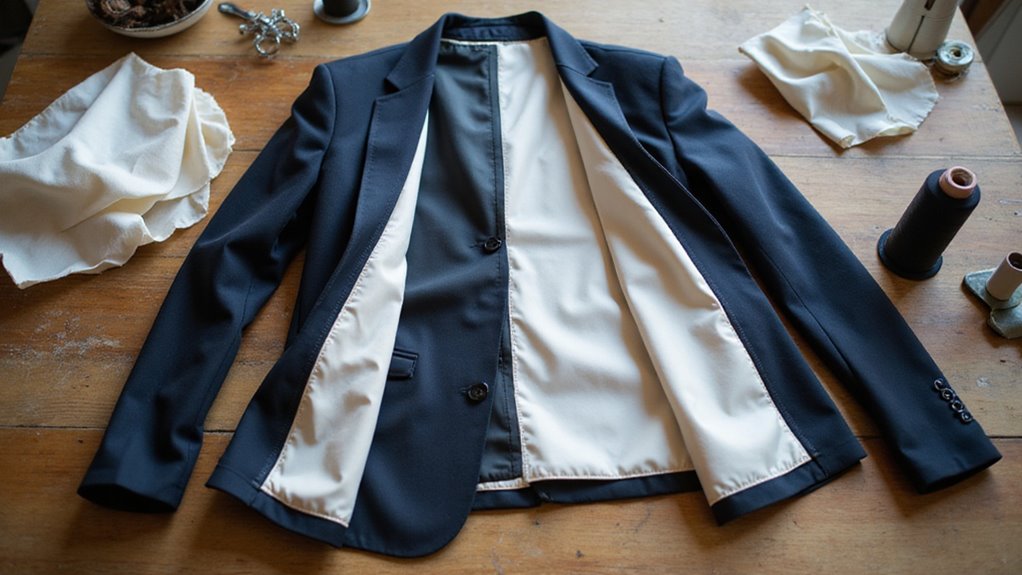
A jacket lining is important for more than just looks. It helps the jacket keep its shape and structure. The lining makes it easier to put on and take off the jacket. Materials like viscose, polyester, silk, or Bemberg feel smooth and comfortable. These materials reduce friction between your skin and the jacket. The lining also covers seams and stress points for extra support.
If you choose the right lining, you can stay comfortable in different weather. A good lining can hide inside stitches and give the jacket a neat look. Many designers use customizable mockup templates to visualize and refine jacket linings before moving to actual production. A key benefit of jacket linings is that they can be easily previewed using editable layers, allowing designers to experiment with different colors and patterns before making a final decision.
Key Factors to Consider When Choosing a Lining
When you choose a jacket lining, prioritize breathability and comfort by selecting fabrics like Bemberg rayon or lightweight cotton. You’ll also want to assess durability and maintenance—polyester linings resist abrasion and are easy to clean, while silk offers luxury but requires careful care.
Details such as fabric weave can also influence the lining’s texture and how it feels against your skin. Balancing these factors ensures your jacket feels good and wears well over time. Additionally, consider how sustainable practices in lining choice can reduce waste and support environmentally friendly fashion initiatives.
Breathability and Comfort
A jacket lining affects how comfortable and breathable the jacket feels. Breathable linings help air circulate and keep you cool. Natural fibers like cotton and silk allow heat and moisture to escape. Blended fabrics, such as cotton-polyester, provide both comfort and airflow.
Mesh or viscose linings work well for light jackets and warm weather. If you want less sweat, avoid 100% synthetic linings. Choosing the right lining keeps your jacket comfortable in different temperatures.
Durability and Maintenance
A strong lining lasts through regular use and is easy to clean. Bemberg rayon, polyester, and silk blends resist damage from wear. Bemberg rayon does not pill or tear easily. Polyester handles many washes without losing its shape. Silk blends combine strength with a soft feel, but pure silk needs gentle care.
If your coat is heavy wool, use a viscose lining for extra strength. Always read care labels before washing. Machine-washable linings save time, but delicate ones may need dry cleaning. Good fabric choices keep your jacket looking new for longer.
Satin Linings: Smooth and Stylish
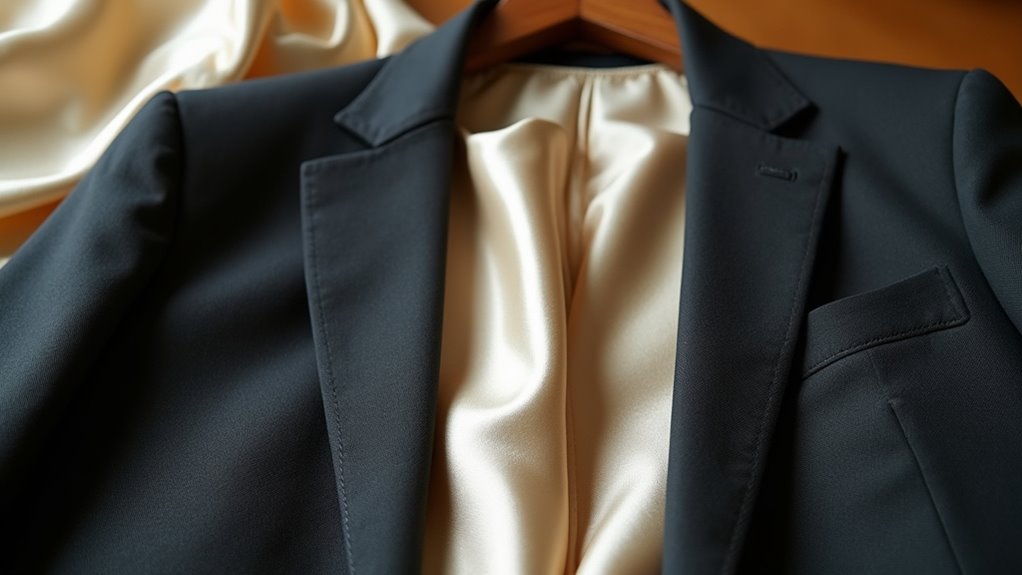
Satin linings are smooth and stylish for jacket interiors. Satin feels soft and has a slight shine. It is made from silk, acetate, or rayon. This fabric helps jackets slide easily over other clothes. Satin linings look elegant and feel comfortable. Satin is often chosen because it helps catch design flaws early, ensuring the final product looks and feels its best.
If you want to customize your jacket, satin offers many color and pattern options. You can pick solid colors or choose bold patterns. Satin is lightweight, so it does not add bulk. This makes satin a good choice for both blazers and evening jackets. For designers, satin linings are easy to personalize and show off in presentations using customizable mockup templates, which help visualize fabric choices and final looks.
Polyester Linings: Affordable and Versatile
When you choose polyester lining, you get a fabric known for its abrasion resistance and easy maintenance—machine washing won’t compromise its structure. Modern polyester blends can also improve breathability and comfort, reducing clamminess inside your jacket.
If you’re looking for a cost-effective option that delivers reliable performance, polyester stands out among synthetic linings. For designers, polyester linings can also be incorporated into realistic mockups to showcase different textures and finishes in jacket presentations. Many designers value polyester for its high customization options, allowing them to tailor the visual presentation of their jackets efficiently.
Durability and Easy Care
Polyester linings are durable and easy to care for. These linings resist abrasion and hold their shape well. Polyester does not snag or tear easily, so jackets last longer. The fabric handles frequent friction without damage. You can wash polyester linings in a machine, saving on dry cleaning costs.
Wrinkles are less of a problem with polyester. If you want easy maintenance, polyester is a good choice. However, the material comes from synthetic sources and is not biodegradable. If you prefer eco-friendly fabrics, you might choose natural fibers instead. Polyester is practical for those who want a long-lasting and low-maintenance jacket lining.
Breathability and Comfort
Polyester linings are less breathable than natural fibers like cotton or silk. Polyester can trap heat and sweat in warm weather or during activity. The tight weave blocks airflow, which may reduce comfort. Polyester feels light and smooth and is often used in modern styles. If you want comfort for long use, keep these points in mind:
- Polyester may make you feel hot if worn for hours.
- Moisture does not escape easily, which can cause discomfort.
- Fashion often uses polyester for its sleek look.
- Polyester is less eco-friendly than natural fibers.
Choose based on your comfort needs and environmental concerns.
Cost-Effective Fabric Choice
Polyester lining is a cost-effective fabric choice for jackets. This material is affordable, making it easy to fit most budgets. Polyester is also versatile and suits different jacket styles. The fabric feels smooth, so jackets slide on easily over clothing. It is lightweight and resists wrinkles, which helps keep jackets looking neat.
Polyester is more durable than delicate fabrics like silk. It rarely tears and holds up well to frequent washing. The lining keeps its color and does not pill easily. Polyester also wicks moisture, making it good for casual or formal jackets. If you want a lining that lasts, polyester is a strong choice.
Cotton Linings: Breathable Comfort
Cotton is a good choice for jacket linings because it is comfortable and lets air pass through. The fabric is gentle on your skin and helps control body temperature. Cotton absorbs moisture, so you will feel dry and comfortable. If you want a lining that does not cause irritation, cotton is a smart pick. Cotton linings can help differentiate high-end fashion through detailed finishing, adding to the overall quality perception of the jacket.
- Cotton feels soft and smooth against your skin.
- It keeps you dry by absorbing sweat.
- Cotton adjusts to changes in temperature throughout the year.
- The fabric lasts long and handles many washes well.
If you pick cotton linings, you get both comfort and style. Cotton also fits well with modern jacket designs. Designers sometimes use PSD mockup templates to visualize how cotton linings will look in finished jackets before producing samples.
Silk Linings: Ultimate Luxury
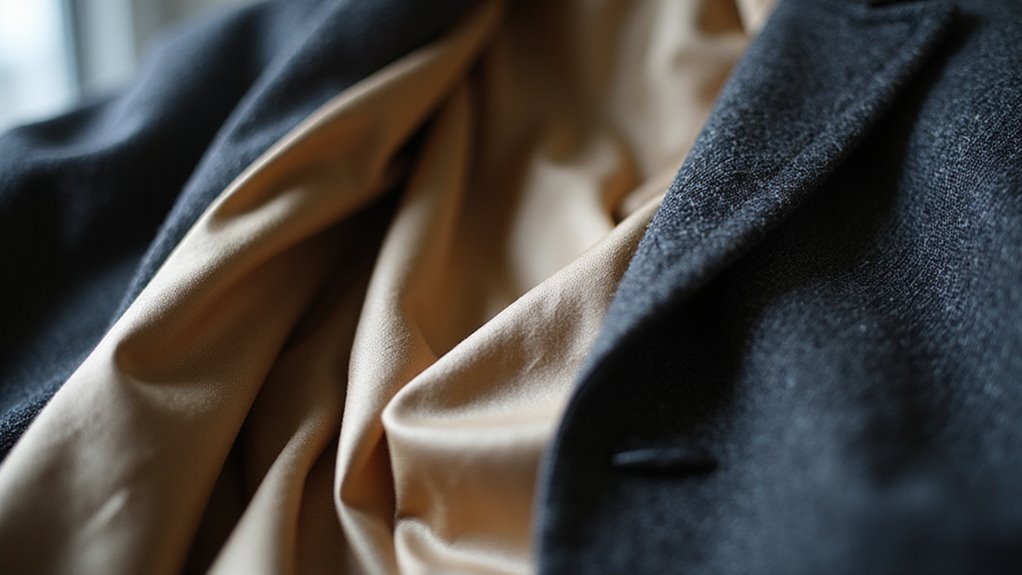
Silk linings are the standard for luxury in jackets. They give a jacket a bright shine and a light, soft feel. Silk has been used in jacket linings for hundreds of years. The smooth surface lets your jacket move easily over other clothes.
Silk is breathable and keeps you comfortable in different temperatures. If you want a lining that feels special, silk is a top choice. You will also benefit from professional cleaning recommendations with silk linings, as this preserves their quality and extends the life of your jacket.
| Feature | Benefit |
|---|---|
| Bright Shine | Adds a stylish look |
| Lightweight | Does not feel heavy |
| Breathable | Keeps you comfortable |
| Smooth Surface | Makes jackets easy to wear |
| Natural Fiber | Good for sensitive skin |
You will feel the difference each time you wear a silk-lined jacket. Many designers showcase the benefits of silk in their high-quality visual assets using realistic mockups to highlight the fabric’s luxurious appeal.
Fleece Linings: Warmth for Cold Weather
Fleece linings add warmth to jackets during cold weather. This material comes from synthetic polyester fibers. Fleece traps air to keep warmth in without adding much weight. The fabric blocks wind and lets your skin breathe.
If you sweat, fleece moves moisture away to keep you dry. Its soft feel makes jackets comfortable for long wear. For those interested in enhancing jacket design, detailed visualization tools used in digital mockups can help evaluate how different linings like fleece will look and perform.
Fleece linings have several benefits:
- Thermal insulation keeps you warm in very cold weather.
- Moisture wicking helps you stay dry during activity.
- Lightweight material allows easy movement.
- Soft texture provides comfort and a sense of security.
For those considering options beyond fleece, exploring high-quality fabrics used in bespoke tailoring can offer both style and functional advantages for jacket linings.
Quilted Linings: Added Insulation
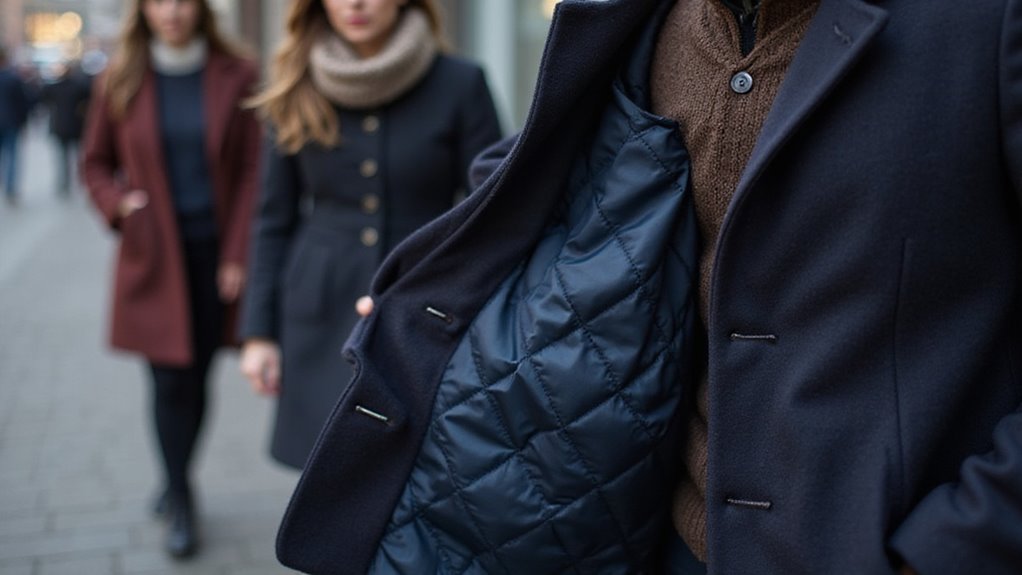
Quilted linings add extra warmth to jackets. This lining uses two fabric layers with soft filling in between. The stitched design keeps the filling in place and helps spread heat evenly. Quilted linings are not bulky but still keep you warm in cold weather.
| Outer Layer (Nylon/Poly) | Batting (Poly Fill/Down) | Inner Layer (Taffeta/Satin) |
|---|---|---|
| Nylon and polyester resist wear | The soft filling traps heat | The inside feels smooth |
| They are light but strong | It adds softness and loft | It helps reduce rubbing |
| Water resistance protects from moisture | Insulation stays in place | Comfort is improved |
If you want a jacket that is warm and comfortable, choose a quilted lining. Many designers use layered materials to improve both the comfort and the functionality of jacket linings.
Wool Linings: Natural Warmth and Durability
Wool linings provide natural warmth and last a long time. Wool traps air, creating a barrier that keeps you warm. It manages moisture, so you feel dry and comfortable inside your jacket. Wool resists pilling and does not lose its shape over time.
If you want reliable insulation, wool is a great choice. It keeps you warm without feeling heavy or bulky. Wool also handles sweat better than many other materials. Its structure stays strong even after many uses. If you care about the environment, wool is biodegradable and eco-friendly. Choose wool linings for warmth, comfort, and durability.
Mesh Linings: Lightweight and Breathable
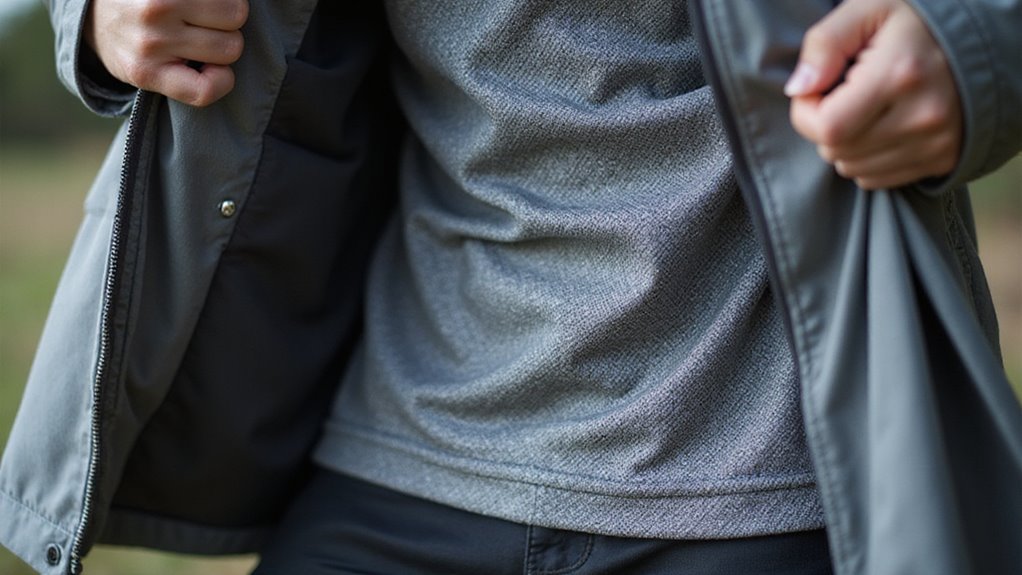
Mesh linings make jackets lightweight and breathable. They use open-weave fibers like polyester or nylon to let air pass through. This design helps sweat dry quickly and keeps you cool during activity. If you wear a jacket with mesh lining, heat buildup is less likely. Many sports and travel jackets use mesh for added comfort.
Modern styles use mesh for its clean look and light feel. Brands often choose recycled polyester to reduce environmental harm. If you want a comfortable and eco-friendly jacket, choose one with a mesh lining. The fine grid pattern of mesh also gives a subtle style under the main fabric. Mesh-lined jackets work well for sports, travel, and daily city wear.
Viscose and Rayon Linings: Soft Alternatives
If you want a lining that feels smooth against your skin, choose viscose or rayon for their superior breathability and comfort. These cellulose-based fabrics drape fluidly, giving your jacket a refined silhouette. You’ll notice their elegant sheen and lightweight structure add both style and practicality to your garment.
Breathability and Comfort
Viscose and rayon provide excellent breathability and comfort as jacket linings. These fibers wick away moisture and keep you cool. If you want a soft lining, viscose and rayon feel gentle against the skin.
Jacket linings made from these materials reduce irritation and minimize friction. Color options have changed over time, from neutral to vibrant or patterned linings. If you choose viscose or rayon, you can enjoy both comfort and style.
- Stay cool and dry in warm weather.
- Feel soft fabric that does not irritate.
- Choose from many colors and patterns.
- Get a light lining that remains strong.
Draping and Aesthetic Appeal
Jacket linings improve how a jacket hangs and looks. Viscose and rayon stand out for their smooth drape and elegant look. Both fabrics are soft and lightweight, so they do not add bulk. Viscose comes from wood pulp, while rayon is a type of cellulose fiber.
Each has a gentle shine that works well with many jacket styles. These linings take dye evenly, so colors match or contrast easily. If you use viscose or rayon, your jacket will move well and look neat. Both options fit modern fashion and add a refined finish.
Acetate Linings: Classic Choice for Suit Jackets
Acetate linings are a popular choice for suit jackets. The fabric feels smooth and looks shiny. Acetate comes from cellulose, which is a plant material. It lets the jacket move easily over other clothes. The material also helps prevent static and keeps the jacket’s shape.
If you want comfort, acetate feels soft against the skin. The shine makes the jacket’s inside look stylish. The fabric is thin, so your jacket stays slim and neat. If you value tradition, acetate connects your suit to classic tailoring.
Comparing Synthetic vs. Natural Linings
When you compare synthetic linings like polyester or acetate with natural options such as silk or cotton, you’ll notice distinct differences in breathability, moisture control, and durability.
Synthetics often resist wrinkles and require less maintenance, but natural fibers excel in comfort and temperature regulation. Consider how each fabric’s texture and care requirements align with your jacket’s intended use.
Breathability and Moisture Control
Different lining materials control breathability and moisture by allowing or blocking air and sweat movement inside a jacket. Natural linings like cotton and silk let air flow and help wick away sweat.
Synthetic linings such as polyester or acetate may hold in heat if they are thick. Some modern synthetic linings use special weaves to increase breathability. Color choices do not affect breathability, but light colors may show sweat marks. Consider these points:
- Cotton and silk linings let your skin breathe and remove moisture well.
- Thick synthetic linings often keep heat in and may cause sweating.
- Microfiber synthetics can offer a good balance of breathability and moisture control.
- The right lining thickness helps make the jacket comfortable in different weather.
Durability and Maintenance
Jacket linings can be natural or synthetic. Natural linings like silk and cotton are less durable and need more care. Silk feels soft but requires dry cleaning and gentle handling. Cotton fades and wears out faster with frequent use.
Synthetic linings such as polyester and viscose last longer and resist wear. These materials keep their color and appearance after many washes. Synthetics are easy to clean and handle higher temperatures. If you want a lining that is strong and easy to maintain, choose a synthetic material.
Comfort and Texture
Comfort and texture are important when choosing a jacket lining. Natural fabrics like silk and cotton feel soft and allow your skin to breathe. These materials help manage moisture and provide a gentle touch. Synthetic linings, such as polyester and acetate, can feel cooler but might not let air through as well.
If the weather is humid, synthetic linings may stick to your skin. The texture of the lining affects how the jacket feels and moves with you. Lining color matters too, as bright or patterned linings can make the jacket look more special.
- Silk is smooth, elegant, and keeps your temperature comfortable.
- Cotton feels soft, does not cause allergies, and has a flat look.
- Polyester is smooth and cheap but does not breathe well.
- Acetate looks shiny, feels light, but can create static.
Tips for Caring for Your Jacket Lining
Jacket linings need gentle care to stay in good shape. Always check the care label before cleaning. Silk and viscose linings should be hand washed with mild detergent or dry cleaned.
Polyester linings are stronger, so you can use a gentle machine cycle with cool water. Use a broad, padded hanger to store your jacket and prevent creasing. If you see stains, spot-clean gently with a soft cloth. Avoid scrubbing, as it can damage delicate fabrics.
Conclusion
If you want your jacket to be comfortable, the right lining is important. Natural fabrics like silk or cotton can last if you care for them. If you need something more affordable, you could choose viscose for its smooth feel.
If warmth is your priority, you might select quilted polyester. Polyester linings can handle frequent use and provide extra insulation. If breathability matters most, cotton or blends may be your best option.
If you carefully consider your needs, your jacket will be both practical and stylish. A thoughtful lining choice can make your jacket last longer and feel better. If you are ready to design your perfect jacket, try Custom Mockup to visualize your selection.



No Comment! Be the first one.